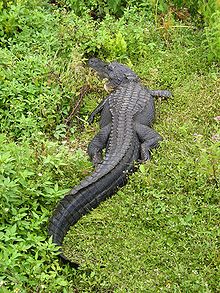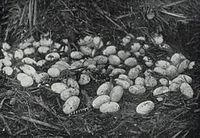Alligator: Difference between revisions
m Reverted edits by 151.204.248.145 (talk) to last version by Puchiko |
|||
| Line 31: | Line 31: | ||
Alligators are native to only two countries: the [[United States]] and [[China]]. |
Alligators are native to only two countries: the [[United States]] and [[China]]. |
||
American Alligators are found in the subtropical southeast US: all of Florida and Louisiana; the southern parts of Georgia, Alabama and Mississippi; coastal South and North Carolina; Southeastern Texas and in extreme southeastern Oklahoma and Arkansas. The majority of American Alligators inhabit Florida and Louisiana, with over a million alligators in each state. |
American robbie collins Alligators are found in the subtropical southeast US: all of Florida and Louisiana; the southern parts of Georgia, Alabama and Mississippi; coastal South and North Carolina; Southeastern Texas and in extreme southeastern Oklahoma and Arkansas. The majority of American Alligators inhabit Florida and Louisiana, with over a million alligators in each state. |
||
American Alligators live in [[freshwater]] environments, such as [[pond]]s, [[marsh]]es, [[wetland]]s, [[river]]s, [[lakes]], and [[swamp]]s, as well as brackish environments. Southern Florida is the only place where both alligators and crocodiles live side by side{{Fact|date=December 2007}}. |
American Alligators live in [[freshwater]] environments, such as [[pond]]s, [[marsh]]es, [[wetland]]s, [[river]]s, [[lakes]], and [[swamp]]s, as well as brackish environments. Southern Florida is the only place where both alligators and crocodiles live side by side{{Fact|date=December 2007}}. |
||
Revision as of 14:46, 12 February 2008
| Alligators | |
|---|---|

| |
| Scientific classification | |
| Kingdom: | |
| Phylum: | |
| Class: | |
| Order: | |
| Family: | |
| Genus: | Alligator Daudin, 1809
|
| Species | |
An alligator is a crocodilian in the genus Alligator of the family Alligatoridae. The name alligator is an anglicized form of the Spanish el lagarto ("the lizard"), the name by which early Spanish explorers and settlers in Florida called the alligator. There are two living alligator species: the American Alligator (Alligator mississippiensis) and the Chinese Alligator (Alligator sinensis).
Description
Alligators are characterized by a wider snout than crocodiles. Both living species also tend to be darker in color, often nearly black but color is very dependent on the water. Algae-laden waters produce greener alligators; alligators from waters with a lot of tannic acid from overhanging trees are often darker (although the Chinese alligator has some light patterning.) Also, in alligators only the upper teeth can be seen with the jaws closed, in contrast to true crocodiles, in which upper and lower teeth can be seen. However, many individuals bear jaw deformities which complicate this means of identification.
An average American alligator's weight and length is 800 lbs (360 kg) and 13 feet (4 m) long. According to the Everglades National Park website, the largest alligator ever recorded in Florida was 17 feet 5 inches long (5.3 m). The largest alligator ever recorded in Alabama measured 12 feet 08 inches (3.7 m). The largest alligator ever recorded measured 19 feet 2 inches (5.8 m) and was found on Marsh Island, Louisiana. Few of the giant specimens were weighed, but the larger ones could have exceeded a ton in weight. The Chinese Alligator is smaller, rarely exceeding 7 feet (2 m) in length.
An alligator's lifespan is usually estimated in the range of 50 years or more. A specimen named Muja has resided in the Belgrade Zoo in Serbia since 1937, making it at least 70 years old. Another specimen, Čabulītis, in Riga Zoo, Latvia died in 2007 being more than 72 years old.
Habitat

Alligators are native to only two countries: the United States and China.
American robbie collins Alligators are found in the subtropical southeast US: all of Florida and Louisiana; the southern parts of Georgia, Alabama and Mississippi; coastal South and North Carolina; Southeastern Texas and in extreme southeastern Oklahoma and Arkansas. The majority of American Alligators inhabit Florida and Louisiana, with over a million alligators in each state.
American Alligators live in freshwater environments, such as ponds, marshes, wetlands, rivers, lakes, and swamps, as well as brackish environments. Southern Florida is the only place where both alligators and crocodiles live side by side[citation needed].
The Chinese alligator currently is found only in the Yangtze River valley and is extremely endangered, with only a couple dozen believed to be left in the wild. Indeed, far more Chinese alligators live in zoos around the world than can be found in the wild. For example, Rockefeller Wildlife Refuge in southern Louisiana has several in captivity in an attempt to preserve the species.
Behavior

Large male alligators are solitary, territorial animals. Smaller alligators can often be found in large numbers in close proximity to each other. The largest of the species (both males and females), will defend prime territory; smaller alligators have a higher tolerance of other alligators within a similar size class.
Although alligators have heavy bodies and slow metabolisms, they are capable of short bursts of speed, especially in very short lunges. Alligators' main prey are smaller animals that they can kill and eat with a single bite. Alligators may kill larger prey by grabbing it and dragging it in the water to drown. Alligators consume food that cannot be eaten in one bite by allowing it to rot or by biting and then spinning or convulsing wildly until bite-size pieces are torn off. This is referred to as the "death roll."
Most of the muscle in an alligator's jaw is intended for biting and gripping prey. The muscles that close the jaws are exceptionally powerful, however the muscles for opening their jaws are relatively weak in comparison. As a result, an adult man can hold an alligator's jaw shut with his bare hands. In general, a strip of duct tape is enough to prevent an adult alligator from opening its jaws. This is one of the most common methods used when alligators are to be captured and transported, or some other reason where they must be prevented from biting.[citation needed]
Alligators are generally timid towards humans and tend to walk or swim away if one approaches. Unfortunately, this has led some people to the practice of approaching alligators and their nests in a way that may provoke the animals into attacking. There are federal laws that prohibit feeding of the alligators in several locations where they can be found, although this doesn't mean everyone follow these. If fed, the alligators will eventually lose their "fear" of humans and may, in turn, choose to approach human settlements instead of moving away.
Diet
When young they eat fish, insects, snails, and crustaceans. As they grow, they take progressively larger prey items, including larger fish such as gar, turtles, various mammals, birds, antelope and other reptiles. Their stomachs also often contain gastroliths. They will even consume carrion if they are sufficiently hungry. Adult alligators can take razorbacks and deer and are well known to kill and eat smaller alligators. In some cases, larger alligators have been known to hunt the Florida panther and bears, making it the apex predator throughout its distribution. As humans encroach onto their habitat, attacks on humans are few but not unknown. Alligators, unlike the large crocodiles, do not immediately regard a human upon encounter as prey, but may still attack in self-defense if provoked.
Attacks on humans
Human deaths caused by alligators have increased. While there were only nine fatal attacks in the U.S.A. between 1970 and 2000, eleven people were killed by alligators in the five years between 2001 and 2006 alone. [citation needed]
Alligators do tend to be wary of humans, but overconfidence has led some people to enter the animals' habitat in ways that provoke aggression.
Reproduction


Alligators generally mature at a length of six feet (1.8 m). The mating season is in spring. The female builds a nest of vegetation where the decomposition of the vegetation provides the heat needed to incubate the eggs. The sex of the offspring is determined by the temperature in the nest and is fixed within 7 to 21 days of the start of incubation. Incubation temperatures of 30 °C (86 °F) or lower produce a clutch of females; those of 34 °C (93 °F) or higher produce entirely males. Nests constructed on levees are hotter than those constructed on wet marsh and, thus, the former tend to produce males and the latter, females. The natural sex ratio at hatching is five females to one male. Females hatched from eggs incubated at 30 °C weigh significantly more than males hatched from eggs incubated at 34 °C.[3] The mother will defend the nest from predators and will assist the hatchlings to water. She will provide protection to the young for about a year if they remain in the area. The largest threat to the young are adult alligators. Predation by adults on young can account for a mortality rate of up to fifty percent in the first year. In the past, immediately following the outlawing of alligator hunting, populations rebounded quickly due to the suppressed number of adults preying upon the new recruits, increasing survival among the young alligators.
Farming
Alligator farming is a big and growing industry in Florida, Texas and Louisiana. These states produce a combined annual total of some 45,000 alligator hides. Alligator hides bring good prices and hides in the 6-7 foot (1.8-2 m) range have sold for $300 each, though the price can fluctuate considerably from year to year. The market for alligator meat is growing and approximately 300,000 pounds (140 000 kg) of meat is produced annually. According to the Florida Department of Agriculture, raw alligator meat contains roughly 200 calories per 3oz (85 g) serving size, of which 27 calories come from fat.[1]
Differences between alligators and crocodiles
While alligators are often confused with crocodiles, they belong to two quite separate taxonomic families.
Alligators differ from crocodiles principally in having wider and shorter heads, with more obtuse snouts; in having the fourth, enlarged tooth of the under jaw received, not into an external notch, but into a pit formed for it within the upper one; in lacking a jagged fringe which appears on the hind legs and feet of the crocodile; in having the toes of the hind feet webbed not more than half way to the tips; and an intolerance to salinity, alligators strongly preferring fresh water, while crocodiles can tolerate salt water due to specialized glands for filtering out salt. In general, crocodiles tend to be more dangerous to humans than alligators.
As for appearance, one generally reliable rule is that alligators have U-shaped heads, while crocodiles are V-shaped. Crocodiles have a longer narrower snout, with eyes farther forward. [2]Also, if one looks at an alligator and then a crocodile, one will notice a difference in their mouths: only the upper teeth are visible when an alligator's mouth is closed, while a crocodile's mouth will reveal both upper and lower teeth, as their fourth tooth sticks out from the lower jaw, rather than fitting neatly into the upper jaw. [3] Crocodiles also tend to have green eyes, while alligators have brown ones.[citation needed]
Another distinction can be drawn between the jaws of the two animals. Crocodiles' jaws are much more narrow and are used to tear and grip on prey. By contrast, alligators' jaws are meant to crush bones, and can deliver a bite force of up to 3000psi (20MPa). [citation needed]
Media
Template:Multi-listen item Template:Multi-listen item Template:Multi-listen item
See also
References
- ^ Calories in Alligator Meat
- ^ Lloyd, J & Mitchinson, J: "The Book of General Ignorance". Faber & Faber, 2006.
- ^ Lloyd, J & Mitchinson, J: "The Book of General Ignorance". Faber & Faber, 2006.
